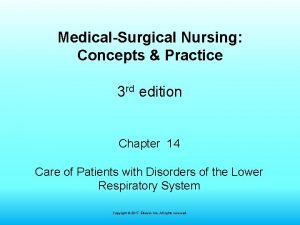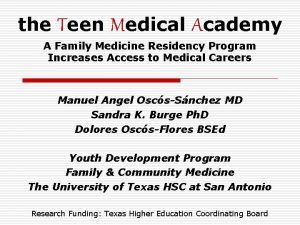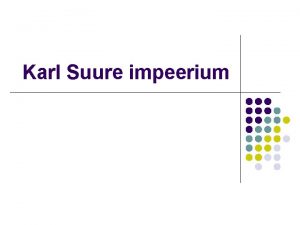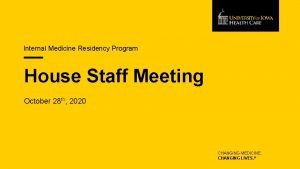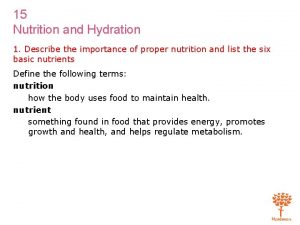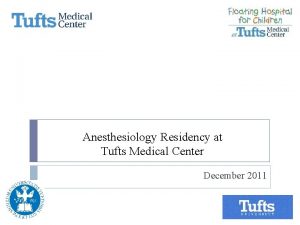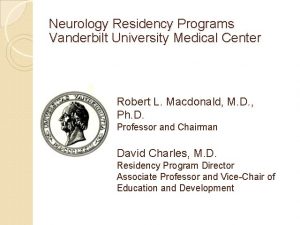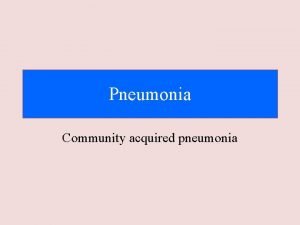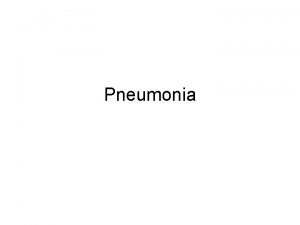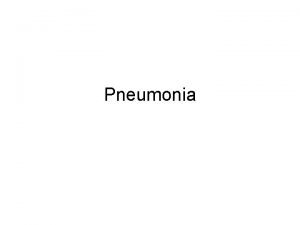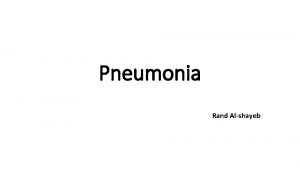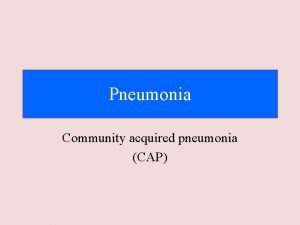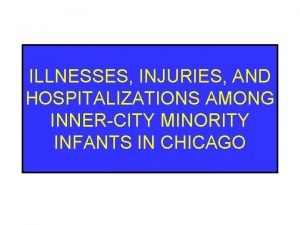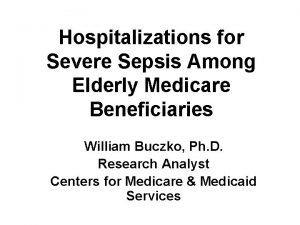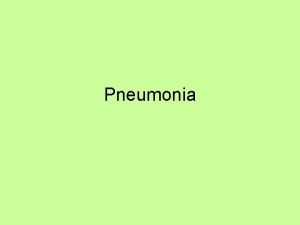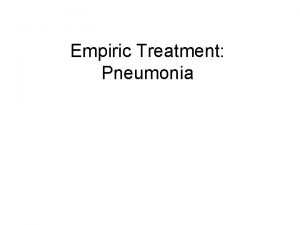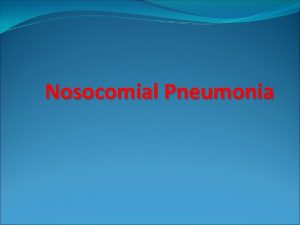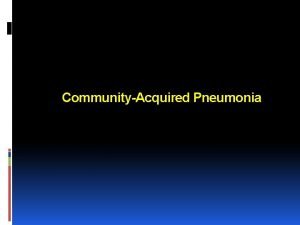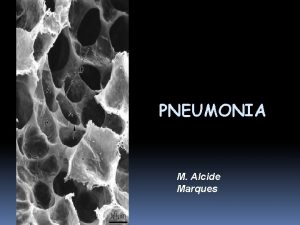Hospitalizations Among Nursing Home Residents with Pneumonia R



















- Slides: 19

Hospitalizations Among Nursing Home Residents with Pneumonia R. Tamara Hodlewsky, MA, MS William Spector, Ph. D Tom Shaffer, MHS

Purpose of the Study n To determine resident-level and facility-level risk factors for hospitalization among nursing facility residents with suspected pneumonia n To focus on the hospitalization decision separately from the risk of acquiring pneumonia

Importance n Approximately 14% of 1. 7 million nursing facility residents get pneumonia during the course of a year n Hospitalization is expensive n Appropriateness of hospitalization not always clear: – Stress of transfer – Risk of nosocomial infection

Literature Review: Large Studies n Larger studies of hospitalization not focused on pneumonia (Freiman & Murtaugh, 1993; Intrator et al. , 1999; Garrard/Kane et al. , 1990) n Hospitalization positively associated with: – Male, Age (up to age 85) – ADL dependency – For-profit status of facility n Hospitalization negatively associated with: – Resident’s tenure in facility – Higher professional staffing

Literature Review: Smaller Studies n Smaller studies including clinical data were specific to hospitalization for pneumonia among nursing home residents n Thompson et al (1997 and 1999): no significant differences in clinical risk factors between hospitalized and unhospitalized n Fried et al (1995 and 1997): Pneumonia cases with higher respiratory rate better off in hospital; pneumonia cases with lower respiratory rate better off staying in facility.

Literature Review: Conclusion n Risk factors for hospitalization for pneumonia remain unclear n No large-scale, national studies of hospitalization from nursing homes focusing on pneumonia

Hypotheses n Probability of hospitalization should be lower for frailer residents n Residents in facilities with higher staffing ratios and more skilled nursing services should have a lower probability of hospitalization n Residents in not-for-profit facilities should have a lower probability of hospitalization

Data n 1996 Medical Expenditure Panel Survey Nursing Home Component (MEPS NHC) n Nationally representative sample of 3, 209 residents as of January 1, 1996 and 2, 690 residents admitted during the year in 815 facilities n 760 residents 65 and older had pneumonia during the year n Of those with pneumonia, 258 (34%) were hospitalized for pneumonia at least once

Capturing Pneumonia n Pneumonia cases are self-reported by facility n Data on incident pneumonias collected in three rounds to ensure complete coverage for all of 1996 n Pneumonias include both incident and at admission

Pneumonia Hospitalizations n Pneumonia hospitalizations were defined as an inpatient admission with reason for admission being pneumonia n Facility self-report

Model LOGIT Model: Hospitalization= f (resident health status, frailty, and diagnoses; resident demographics; facility characteristics and staffing) *Clustering with robust standard errors used to account for correlation among residents in the same facility *Probability weights used to account for complex survey design

Resident-Level Variables n n n n n ADL dependence Incontinence Cognitive performance Trouble chewing Trouble swallowing Body Mass Index Heart Disease Cancer Emphysema/COPD n n n n Stroke Depression Other comorbidities DNH advance directive Gender Race Level of education Age 95+

Facility-Level Variables n For-profit, not-for-profit, or government status n Chain or independent n Rural or urban n Total number of beds n Percent of beds certified for Medicare n RN- and LPN- to resident ratio n Nurse aide-to-resident ratio n Skilled nursing services offered: tube-feeding, IV therapy, isolation, dialysis, ventilator care

Preliminary Results: Facility-Level (Dep. Var. : Hospitalization) n n n Not-for-profit status** (negative) RN+LPN-to-resident ratio** (negative) Aide-to-resident ratio** (positive) Percent Medicare beds** (negative) Skilled nursing services available** (negative) (tube feeding, isolation, vent care, dialysis, IV) **p<. 05

Preliminary Results: Resident. Level (Dep. Var. : Hospitalization) n n n Problems chewing** (negative) Cancer** (negative) Depression* (positive) High school education* (negative) Education beyond high school** (negative) **p<. 05 *p<. 10

Limitations n Lack of clinical data on pneumonia infections, such as respiratory rate n No clinical definition for pneumonia used n Pneumonia and hospitalization based on facility report

Key Findings of No Statistical Significance n Race and gender n Urban/rural n Chain/Independent

Implications n Potential to reduce pneumonia hospitalizations and associated costs through increased professional staffing and skilled nursing capabilities in nursing facilities n Need for outcomes data to assess avoidable and unavoidable hospitalizations for pneumonia

Next Steps n Sensitivity Analyses n More input on clinical significance of risk factors and magnitudes of effects
 Nursing care plan for pneumonia
Nursing care plan for pneumonia Poor feeding nursing diagnosis
Poor feeding nursing diagnosis Unmc obgyn residents
Unmc obgyn residents Uthscsa internal medicine residents
Uthscsa internal medicine residents Dr somer shely
Dr somer shely Famous yonkers residents
Famous yonkers residents Qualifying shift paro
Qualifying shift paro Uw neurological surgery
Uw neurological surgery Karl suure impeerium
Karl suure impeerium Uihc internal medicine residents
Uihc internal medicine residents St louis family medicine residency
St louis family medicine residency Post campaign analysis presentation
Post campaign analysis presentation Umass neurology residency
Umass neurology residency How can an na best help residents with eating?
How can an na best help residents with eating? Internal tourism includes
Internal tourism includes Tufts medical center anesthesiology residency
Tufts medical center anesthesiology residency Uf neurology residents
Uf neurology residents Unm internal medicine
Unm internal medicine Vanderbilt nurse residency interview questions
Vanderbilt nurse residency interview questions Personal care skills chapter 13
Personal care skills chapter 13
